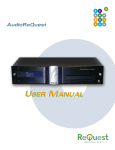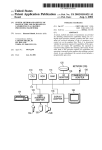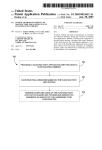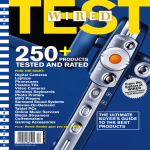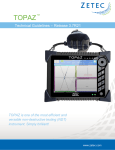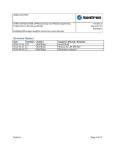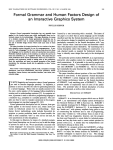Download Memory resource arbitrator for multiple gate arrays
Transcript
US 20020010825A1 (19) United States (12) Patent Application Publication (10) Pub. No.: US 2002/0010825 A1 (43) Pub. Date: Wilson (54) Jan. 24, 2002 MEMORY RESOURCE ARBITRATOR FOR is a non-provisional of provisional application No. MULTIPLE GATE ARRAYS 60/219,808, ?led on Jul. 20, 2000. Publication Classi?cation (76) Inventor: Alex Wilson, Oxford (GB) Correspondence Address: (51) Int. Cl? ........................ .. G06F 12/00; G06F 13/14; KEVIN J. ZILKA PO. BOX 721120 (52) Us. 01. ............................................................ ..710/240 G06F 13/38 SAN JOSE, CA 95172-1120 (US) (57) (21) Appl. No.: (22) Filed: 09/841,701 ABSTRACT A system, method and computer program product for arbi trating access to a shared memory resource by a plurality of Apr. 23, 2001 gate arrays. During use, operations are executed on a plu Related US. Application Data rality of gate arrays. Further, the gate arrays are alloWed (63) Continuation-in-part of application No. 09/687,481, execution of the operations thereon. Such access to the at least one shared memory resource is arbritrated to prevent access to at least one shared memory resource during the ?led on Oct. 12, 2000. Continuation-in-part of appli cation No. 09/687,012, ?led on Oct. 12, 2000, Which con?ict betWeen the gate arrays. 120 NETWORK (135) 110 124 116 114 \ \ CPU ROM RAM-l ADAPTER 112 122 \ HO 13\6 USER 111114? I 132 126 [8128 DISPLAY 118 134 / / COMMUNICATION ADAPTER 138 \ Patent Application Publication Jan. 24, 2002 Sheet 1 0f 4 US 2002/0010825 A1 120 110\ 116\ @ NETWORK(135) ‘X 1/34 114\ 118 / 1/0 COMMUNICATION CFLI Roi] RAM-l ADAPTERI ADAPTER 136 \ USER 111111? | DISPLAY 132$ 126% [8128 Fig. 1 138 P [:l Patent Application Publication Jan. 24, 2002 Sheet 2 0f 4 US 2002/0010825 A1 200 CPU / . PARALLEL PORT ______._.__.___.__ FPGA 204 206 Fig. 2 2°8 Patent Application Publication Jan. 24, 2002 Sheet 3 0f 4 US 2002/0010825 A1 300 K 302 EXECUTING OPERATIONS ON A PLURALITY OF GATE ARRAYS V 304 ALLOWING ACCESS TO AT LEAST ONE SHARED MEMORY RESOURCE BY THE GATE ARRAYS DURING THE EXECUTION OF THE OPERATIONS THEREON ARBIRTRATING THE ACCESS TO THE AT LEAST ONE SHARED MEMORY RESOURCE TO PREVENT CONFLICT BETWEEN THE GATE ARRAYS Fig. 3 K Patent Application Publication Jan. 24, 2002 Sheet 4 0f 4 US 2002/0010825 A1 400 / Filename Purpose Blizzard - h MMT2000 header ?le Fig. 4 500 Filename Tvne Macro Name Purpose Fp0server.h Resource server FpOserverO Resource sewer for FPO for the Audiorequesc.h Audio Server AudioRequest () Audio server for allowing sharing of Flashrequest.h Data server FlashRequestO Mp3request.h MP3 server MP3Request () MMT2000 lPPhone/MP3 project sound hardware Sewer for allowing FP1 access to the FLASH memory Sewer to control the MP3 application and feed it MP3 bitstream data when requested. Reccnfigurerequest: .h Fpgacomms.h Reconfiguration Reconfigurereq Allows FP1 to request to be hardware nest () recon?gured, at an application exit. Implements two unidirectional 16 bit Communications hardware channels for communicating between the two FPGAs Fig. 5 Jan. 24, 2002 US 2002/0010825 A1 MEMORY RESOURCE ARBITRATOR FOR MULTIPLE GATE ARRAYS RELATED APPLICATION(S) [0001] The present application is a continuation-in-part of a parent application ?led Oct. 12, 2000 under Ser. No. 09/687,481, and is further a continuation-in-part of a parent [0007] Finally, in systems having a relatively large number of requestor lines, it is highly probable that one or more of the requestor lines Will not be used by any of the requesters. It has been found that under certain conditions a requestor line Which is not connected to a requestor may temporarily be mistaken as a requesting processor. Acknowledgement of such “spurious” requests results in Wasted memory time and overhead. application ?led Oct. 12, 2000 under Ser. No. 09/687,012 Which in turn claims priority of a provisional application ?led Jul. 20, 2000 under Ser. No. 60/219,808. [0008] It is Well knoWn that softWare-controlled machines provide great ?exibility in that they can be adapted to many FIELD OF THE INVENTION different desired purposes by the use of suitable softWare. As Well as being used in the familiar general purpose comput [0002] The present invention relates to resource arbitra ers, softWare-controlled processors are noW used in many tion and more particularly to alloWing multiple hardWare products such as cars, telephones and other domestic prod modules, i.e. gate arrays, to access shared resources. ucts, Where they are knoWn as embedded systems. BACKGROUND OF THE INVENTION [0003] Multiprocessing techniques have become Widely used in computing systems. Essentially, multiprocessing systems employ a plurality of processing devices operated [0009] HoWever, for a given a function, a softWare-con trolled processor is usually sloWer than hardWare dedicated to that function. AWay of overcoming this problem is to use a special softWare-controlled processor such as a RISC processor Which can be made to function more quickly for substantially independent from one another to thereby limited purposes by having its parameters (for instance siZe, enable the computing system to simultaneously accomplish instruction set etc.) tailored to the desired functionality. a variety of different tasks. [0004] Rather than provide each of the processers With a separate mass storage memory, multiprocessing systems generally employ a single mass storage device, such as core memory. Each of the processors in the multiprocessing system must therefore communicate With the single mass storage device When a memory instruction is to be per formed by the associated processing system. Since a single memory may be accessed by a single requestor at any one time, a technique must be devised for choosing betWeen tWo or more processors Which desire to access the central memory at the same time. [0005] Prior art techniques for selecting the processor have generally involved the use of discrete combinatorial and sequential logic elements and have therefore been highly complex and cumbersome in use. Further, such prior art techniques are relatively in?exable in operation, thus limiting the ability of such system to accommodate for particular contingency. For example, in many systems, the routine priority scheme may be upset by special memory requests, such as a multi-cycle request Where the requesting processor requires a memory access involving more than a single memory cycle. Other special priority requests include “super priority” requests such as memory refresh cycles Which must be performed to the exclusion of all other memory accesses. The prior art techniques employing dis crete components cannot easily accommodate such non routine memory requests Without involving highly complex circuitry. [0006] Additionally, it is important that priority assign ments not be static in nature. That is, priorities should be rotated on a predetermined basis such that all requesters Will be given an equal opportunity to access memory, assuming [0010] Where hardWare is used, though, although it increases the speed of operation, it lacks ?exibility and, for instance, although it may be suitable for the task for Which it Was designed it may not be suitable for a modi?ed version of that task Which is desired later. It is noW possible to form the hardWare on recon?gurable logic circuits, such as Field Programmable Gate Arrays (FPGA’s) Which are logic cir cuits Which can be repeatedly recon?gured in different Ways. Thus they provide the speed advantages of dedicated hard Ware, With some degree of ?exibility for later updating or multiple functionality. [0011] Varoius computer boards, such as the MMT2000® board, are designed in such a Way that tWo FPGAs are connected to each physical device on the board. Thus each is individually able to drive all of the devices on the board. HoWever, tWo main problems arise When trying to access a resource from both FPGAs. [0012] In particular, the ?rst problem is related to external memory and arises because Handel-C, a programming lan guage for programming FPGAs, is not able to tristate the control and address lines to external RAMs. Thus, each RAM bank (and the FLASH memory Which shares address pins With one of the RAM banks) can only be accessed from one FPGA. [0013] The second problem arises When trying to transfer control of a device from one FPGA to the other, both because most existing device drivers are not designed to exit cleanly and because even if they did, most devices Would require resetting and reinitialising every time control Was transferred (an unnecessarily time-consuming procedure). SUMMARY OF THE INVENTION that such is desired. For example, if requestor 1 has priority over requestor 2 at all times, requestor 2 Will clearly be given less opportunity With access memory compared to requestor [0014] A system, method and computer program product 1. The priorities must therefore be rotated over time to effect plurality of gate arrays. During use, operations are executed an equal distribution among the requesters. This requires on a plurality of gate arrays. Further, the gate arrays are for arbitrating access to a shared memory resource by a complex sequential logic When implemented in discrete alloWed access to at least one shared memory resource form leading to a complex and cumbersome system. during the execution of the operations thereon. Such access Jan. 24, 2002 US 2002/0010825 A1 to the at least one shared memory resource is arbritrated to parallel port 204. In one embodiment, the gate arrays are prevent con?ict betWeen the gate arrays. positioned on a MMT2000® dual Vertex board. [0015] In one embodiment of the present invention, the arbitration step avoids reinitialiZation of the device drivers on the gate arrays. To accomplish this, the arbitration step XC2000® and XC3000TM families of FPGA devices intro may include locking the at least one shared memory resource While communications are in progress With the gate [0023] Examples of such FPGA devices include the duced by Xilinx, Inc. of San Jose, Calif. The architectures of these devices are exempli?ed in US. Pat. Nos. 4,642,487; arrays, preventing server data from being interleaved With other data, preventing a sound driver from locking access to the at least one shared memory, and/or controlling a graphi 4,706,216; 4,713,557; and 4,758,985; each of Which is originally assigned to Xilinx, Inc. and Which are herein incorporated by reference for all purposes. It should be noted, hoWever, that FPGA’s of any type may be employed cal user interface. in the context of the present invention. BRIEF DESCRIPTION OF THE DRAWINGS [0016] The invention Will be better understood When con sideration is given to the folloWing detailed description thereof. Such description makes reference to the annexed [0024] An FPGA device can be characteriZed as an inte grated circuit that has four major features as folloWs. [0025] (1) A user-accessible, con?guration-de?ning memory means, such as SRAM, PROM, EPROM, EEPROM, anti-fused, fused, or other, is provided in the draWings Wherein: FPGA device so as to be at least once-programmable by [0017] FIG. 1 is a schematic diagram of a hardWare implementation of one embodiment of the present invention; device users for de?ning user-provided con?guration [0018] FIG. 2 is a schematic diagram of one embodiment of the present invention Where the central processing unit interfaces With a pair of gate arrays via a parallel port; [0019] FIG. 3 illustrates a method for arbitrating access to a shared memory resource by a plurality of gate arrays; and [0020] FIGS. 4 and 5 illustrate various external depen dencies and Handel-C Macros, respectively, in accordance With one embodiment of the present invention. DETAILED DESCRIPTION OF THE PREFERRED EMBODIMENTS [0021] Apreferred embodiment of a system in accordance With the present invention is preferably practiced in the context of a personal computer such as an IBM compatible personal computer, Apple Macintosh computer or UNIX based Workstation. A representative hardWare environment is depicted in FIG. 1, Which illustrates a typical hardWare instructions. Static Random Access Memory or SRAM is of course, a form of reprogrammable memory that can be differently programmed many times. Electri cally Erasable and reProgrammable ROM or EEPROM is an example of nonvolatile reprogrammable memory. The con?guration-de?ning memory of an FPGA device can be formed of mixture of different kinds of memory elements if desired (e.g., SRAM and EEPROM) although this is not a popular approach. [0026] (2) Input/Output Blocks (IOB’s) are provided for interconnecting other internal circuit components of the FPGA device With external circuitry. The IOB’s’ may have ?xed con?gurations or they may be con?g urable in accordance With user-provided con?guration instructions stored in the con?guration-de?ning memory means. [0027] (3) Con?gurable Logic Blocks (CLB’s) are pro vided for carrying out user-programmed logic functions as de?ned by user-provided con?guration instructions stored in the con?guration-de?ning memory means. con?guration of a Workstation in accordance With a pre ferred embodiment having a central processing unit 110, such as a microprocessor, and a number of other units interconnected via a system bus 112. The Workstation shoWn in FIG. 1 includes a Random Access Memory (RAM) 114, Read Only Memory (ROM) 116, an I/O adapter 118 for [0028] Typically, each of the many CLB’s of an FPGA has at least one lookup table (LUT) that is user-con?gurable to de?ne any desired truth table,—to the extent alloWed by the address space of the LUT. Each CLB may have other resources such as LUT input signal pre-processing resources connecting peripheral devices such as disk storage units 120 to the bus 112, a user interface adapter 122 for connecting and LUT output signal post-processing resources. Although the term ‘CLB’ Was adopted by early pioneers of FPGA a keyboard 124, a mouse 126, a speaker 128, a microphone technology, it is not uncommon to see other names being 132, and/or other user interface devices such as a touch screen (not shoWn) to the bus 112, communication adapter 134 for connecting the Workstation to a communication netWork (e.g., a data processing netWork) and a display adapter 136 for connecting the bus 112 to a display device 138. The Workstation typically has resident thereon an operating system such as the Microsoft WindoWs NT or Windows/95 Operating System (OS), the IBM OS/2 oper ating system, the MAC OS, or UNIX operating system. Those skilled in the art Will appreciate that the present invention may also be implemented on platforms and oper ating systems other than those mentioned. [0022] FIG. 2 is a schematic diagram of one embodiment 200 of the present invention Where the central processing unit 110 interfaces With a pair of gate arrays 206 via a given to the repeated portion of the FPGA that carries out user-programmed logic functions. The term, ‘LAB’ is used for example in US. Pat. No. 5,260,611 to refer to a repeated unit having a 4-input LUT. [0029] (4) An interconnect netWork is provided for carrying signal traf?c Within the FPGA device betWeen various CLB’s and/or betWeen various IOB’s and/or betWeen various IOB’s and CLB’s. At least part of the interconnect netWork is typically con?gurable so as to alloW for programmably-de?ned routing of signals betWeen various CLB’s and/or IOB’s in accordance With user-de?ned routing instructions stored in the con?guration-de?ning memory means. [0030] In some instances, FPGA devices may additionally include embedded volatile memory for serving as scratchpad US 2002/0010825 A1 memory for the CLB’s or as FIFO or LIFO circuitry. The embedded volatile memory may be fairly sizable and can have 1 million or more storage bits in addition to the storage J an. 24, 2002 from a remote site or from the local site of the FPGA), there are certain practical considerations that may make such in-system reprogrammability of FPGA’s more dif?cult than bits of the device’s con?guration memory. ?rst apparent (that is, When conventional techniques for [0031] Modern FPGA’s tend to be fairly complex. They typically offer a large spectrum of user-con?gurable options FPGA recon?guration are folloWed). With respect to hoW each of many CLB’s should be con?g ured, hoW each of many interconnect resources should be con?gured, and/or hoW each of many IOB’s should be con?gured. This means that there can be thousands or [0038] A popular class of FPGA integrated circuits (IC’s) relies on volatile memory technologies such as SRAM (static random access memory) for implementing on-chip con?guration memory cells. The popularity of such volatile memory technologies is oWed primarily to the inherent millions of con?gurable bits that may need to be individu ally set or cleared during con?guration of each FPGA device. reprogrammability of the memory over a device lifetime that can include an essentially unlimited number of reprogram [0032] Rather than determining With pencil and paper hoW [0039] There is a price to be paid for these advantageous features, hoWever. The price is the inherent volatility of the each of the con?gurable resources of an FPGA device should be programmed, it is common practice to employ a computer and appropriate FPGA-con?guring softWare to automatically generate the con?guration instruction signals that Will be supplied to, and that Will ultimately cause an unprogrammed FPGA to implement a speci?c design. (The con?guration instruction signals may also de?ne an initial state for the implemented design, that is, initial set and reset states for embedded ?ip ?ops and/or embedded scratchpad memory cells.) [0033] The number of logic bits that are used for de?ning the con?guration instructions of a given FPGA device tends to be fairly large (e.g., 1 Megabits or more) and usually groWs With the siZe and complexity of the target FPGA. Time spent in loading con?guration instructions and veri fying that the instructions have been correctly loaded can become signi?cant, particularly When such loading is carried out in the ?eld. [0034] For many reasons, it is often desirable to have ming cycles. con?guration data as stored in the FPGA device. Each time poWer to the FPGA device is shut off, the volatile con?gu ration memory cells lose their con?guration data. Other events may also cause corruption or loss of data from volatile memory cells Within the FPGA device. [0040] Some form of con?guration restoration means is needed to restore the lost data When poWer is shut off and then re-applied to the FPGA or When another like event calls for con?guration restoration (e.g., corruption of state data Within scratchpad memory). [0041] The con?guration restoration means can take many forms. If the FPGA device resides in a relatively large system that has a magnetic or optical or opto-magnetic form of nonvolatile memory (e.g., a hard magnetic disk)—and the latency of poWering up such a optical/magnetic device and/or of loading con?guration instructions from such an optical/magnetic form of nonvolatile memory can be toler ated—then the optical/magnetic memory device can be used in-system reprogramming capabilities so that recon?gura as a nonvolatile con?guration restoration means that redun tion of FPGA’s can be carried out in the ?eld. dantly stores the con?guration data and is used to reload the same into the system’s FPGA device(s) during poWer-up [0035] FPGA devices that have con?guration memories of the reprogrammable kind are, at least in theory, ‘in-system programmable’ (ISP). This means no more than that a possibility eXists for changing the con?guration instructions operations (and/or other restoration cycles). [0042] On the other hand, if the FPGA device(s) resides in a relatively small system that does not have such optical/ Within the FPGA device While the FPGA device is ‘in magnetic devices, and/or if the latency of loading con?gu system’ because the con?guration memory is inherently reprogrammable. The term, ‘in-system’ as used herein indi ration memory data from such an optical/magnetic device is not tolerable, then a smaller and/or faster con?guration cates that the FPGA device remains connected to an appli restoration means may be called for. cation-speci?c printed circuit board or to another form of end-use system during reprogramming. The end-use system [0043] Many end-use systems such as cable-TV set tops, satellite receiver boXes, and communications sWitching is of course, one Which contains the FPGA device and for Which the FPGA device is to be at least once con?gured to boXes are constrained by prespeci?ed design limitations on operate Within in accordance With prede?ned, end-use or ‘in the ?eld’ application speci?cations. sions and/or other provisions such that they cannot rely on magnetic or optical technologies (or on netWork/satellite [0036] The possibility of recon?guring such inherently doWnloads) for performing con?guration restoration. Their reprogrammable FPGA’s does not mean that con?guration changes can alWays be made With any end-use system. Nor does it mean that, Where in-system reprogramming is pos sible, that recon?guration of the FPGA can be made in timely fashion or convenient fashion from the perspective of the end-use system or its users. (Users of the end-use system can be located either locally or remotely relative to the end-use system.) physical siZe and/or poWer-up timing and/or security provi designs instead call for a relatively small and fast acting, non-volatile memory device (such as a securely-packaged EPROM IC), for performing the con?guration restoration function. The small/fast device is eXpected to satisfy appli cation-speci?c criteria such as: (1) being securely retained Within the end-use system; (2) being able to store FPGA con?guration data during prolonged poWer outage periods; and (3) being able to quickly and automatically re-load the con?guration instructions back into the volatile con?gura [0037] Although there may be many instances in Which it tion memory (SRAM) of the FPGA device each time poWer is desirable to alter a pre-eXisting con?guration of an ‘in the is turned back on or another event calls for con?guration ?eld’ FPGA (With the alteration commands coming either restoration. Jan. 24, 2002 US 2002/0010825 A1 [0044] The term ‘CROP device’ Will be used herein to refer in a general Way to this form of compact, nonvolatile, and fast-acting device that performs ‘Con?guration-Restor ing On PoWer-up’ services for an associated FPGA device. Jan. 29, 2001 under Ser. No. 09/772,555, and Which is incorporated herein by reference in its entirety. [0052] FIG. 3 illustrates a method 300 for arbitrating access to a shared memory resource by a plurality of gate tile, and it is generally not ‘in-system programmable’. arrays. During use, operations are executed on a plurality of gate arrays, as indicated in step 302. In one embodiment, the gate arrays included FPGA’s. Instead, the CROP device is generally of a completely [0053] Further, in operation 304, the gate arrays are [0045] Unlike its supported, volatilely reprogrammable FPGA device, the corresponding CROP device is not vola nonprogrammable type such as exempli?ed by mask-pro grammed ROM IC’s or by once-only programmable, fuse based PROM IC’s. Examples of such CROP devices include a product family that the Xilinx company provides under the designation ‘Serial Con?guration PROMs’ and under the trade name, XC1700D.TM. These serial CROP devices employ one-time programmable PROM (Programmable Read Only Memory) cells for storing con?guration instruc tions in nonvolatile fashion. alloWed access to at least one shared memory resource during the execution of the operations thereon. Such access to the at least one shared memory resource is arbritrated to prevent con?ict betWeen the gate arrays. See operation 306. [0054] The present invention alloWs access to external memory and FLASH from both gate arrays Whilst using the RAM construct. Further, it provides arbitration thus prevent ing con?icts When both FPGAs are accessing the same resource. Also, the present invention removes the need to [0046] Apreferred embodiment is Written using Handel-C. stop and reinitialiZe drivers and hardWare When passing Handel-C is a programming language marketed by Celoxica Limited. Handel-C is a programming language that enables from one FPGA to the other. a softWare or hardWare engineer to target directly FPGAs (Field Programmable Gate Arrays) in a similar fashion to classical microprocessor cross-compiler development tools, Without recourse to a HardWare Description Language. Thereby alloWing the designer to directly realiZe the raW real-time computing capability of the FPGA. [0047] Handel-C is designed to enable the compilation of programs into synchronous hardWare; it is aimed at com piling high level algorithms directly into gate level hard Ware. [0048] The Handel-C syntax is based on that of conven tional C so programmers familiar With conventional C Will recogniZe almost all the constructs in the Handel-C lan guage. [0055] One of the key features of the MMT2000® board includes the ability to recon?gure itself both from Flash and over the Ethernet. It is apparent that there is a natural division of the roles of the tWo FPGAs. One (the server, or FPO) has access to the Flash and the NetWork and includes the recon?guration device driver. The other (the client application or FP1) has control over the display, touchscreen and the audio chip. [0056] The present invention encapsulates a bi-directional 16 bit communications driver for alloWing the tWo FPGAs to talk to each other. Every message from one FPGA to the other is preceded by a 16 bit ID, the high eight bits of Which identify the type of message (AUDIO, FLASH, RECON FIGURATION etc . . . ) and the loW identify the particular request for that hardWare (FLASH_READ etc . . . The identi?er codes are processed in a header ?le (e.g. [0049] Sequential programs can be Written in Handel-C just as in conventional C but to gain the most bene?t in performance from the target hardWare its inherent parallel ism must be exploited. [0050] Handel-C includes parallel constructs that provide the means for the programmer to exploit this bene?t in his applications. The compiler compiles and optimiZes Han del-C source code into a ?le suitable for simulation or a net “fp0server.h” in the context of the Handel-C programming language), and then an appropriate macro procedure is called for each type of message (eg for AUDIOQAudioRequest) Which then receives and processes the main body of the communication. [0057] The server process requires a number of parameters to be passed to it. Such parameters Will noW be set forth. list Which can be placed and routed on a real FPGA. [0058] PID: Used for locking shared resources (such as the FLASH) from other processes While communica [0051] More information regarding the Handel-C pro gramming language may be found in “EMBEDDED SOLU TIONS Handel-C Language Reference Manual: Version [0059] usendCommand, uSendLock: A channel alloW 3,”“EMBEDDED SOLUTIONS Handel-C User Manual: Version 3.0,”“EMBEDDED SOLUTIONS Handel-C Inter facing to other language code blocks: Version 3.0,” each authored by Rachel GanZ, and published by Celoxica Lim ited in the year of 2001; and “EMBEDDED SOLUTIONS Handel-C Preprocessor Reference Manual: Version 2.1,” also authored by Rachel GanZ and published by Embedded Solutions Limited in the year of 2000; and Which are each incorporated herein by reference in their entirety. Additional information may also be found in a co-pending application entitled “SYSTEM, METHOD AND ARTICLE OF MANU FACTURE FOR INTERFACE CONSTRUCTS IN A PRO GRAMMING LANGUAGE CAPABLE OF PROGRAM MING HARDWARE ARCHITECTURES” Which Was ?led tions are in progress. ing applications on FPO to send commands to applica tions on FP1 and a one-bit locking variable to ensure the data is not interleaved With server-sent data. [0060] uSoundOut, uSoundIn: TWo channels mirroring the function of the audio driver. Data sent to uSound Out Will be played (assuming the correct code in FP1) out of the MMT2000® speakers, and data read from uSoundIn is the input to the MMT2000® microphone. The channels are implemented in such a Way that When the sound driver blocks, the communication channel betWeen FPGAs is not held up. [0061] MP3Run: A one bit variable controlling the MP3 GUI. The server Will activate or deactivate the MP3 GUI on receipt of commands from FP1. Jan. 24, 2002 US 2002/0010825 A1 [0062] Con?gAddr: A 23 bit channel controlling the (b) computer code for alloWing access to at least one recon?guration process. When the ?ash address of a valid FPGA bit?le is sent to this channel, the server shared memory resource by the gate arrays during the execution of the operations thereon; and recon?gures FP1 With the bitmap speci?ed. [0063] During use, the data transfer rate betWeen the tWo FPGAs in either direction is 16 bits per 5 clock cycles (in the clock domain of the sloWest FPGA). This is the maximum possible reliable rate for communicating betWeen FPGAs that may be running at different clock rates. FIGS. 4 and 5 illustrate various external dependencies 400 and Handel-C Macros 500, respectively, in accordance With one embodi ment of the present invention. Note Appendix A. [0064] While various embodiments have been described above, it should be understood that they have been presented by Way of example only, and not limitation. Thus, the breadth and scope of a preferred embodiment should not be limited by any of the above described exemplary embodi ments, but should be de?ned only in accordance With the folloWing claims and their equivalents. What is claimed is: 1. A method for arbitrating access to a shared memory resource by a plurality of gate arrays, comprising the steps of: (a) executing operations on a plurality of gate arrays; (b) alloWing access to at least one shared memory resource by the gate arrays during the execution of the operations thereon; and (c) arbirtrating the access to the at least one shared memory resource to prevent con?ict betWeen the gate arrays. 2. A method as recited in claim 1, Wherein arbitration step avoids reinitialiZation of the device drivers on the gate arrays. 3. A method as recited in claim 1, Wherein the arbitration step includes locking the at least one shared memory resource While communications are in progress With the gate arrays. 4. A method as recited in claim 1, Wherein the arbitration step includes preventing server data from being interleaved With other data. 5. A method as recited in claim 1, Wherein the arbitration step includes preventing a sound driver from locking access to the at least one shared memory resource. 6. A method as recited in claim 1, Wherein the arbitration step includes controlling a graphical user interface. 7. A computer program product for arbitrating access to a shared memory resource by a plurality of gate arrays, comprising: (a) computer code for executing operations on a plurality of gate arrays; (c) computer code for arbirtrating the access to the at least one shared memory resource to prevent con?ict betWeen the gate arrays. 8. A computer program product as recited in claim 7, Wherein arbitration step avoids reinitialiZation of the device drivers on the gate arrays. 9. A computer program product as recited in claim 7, Wherein the arbitration step includes locking the at least one shared memory resource While communications are in progress With the gate arrays. 10. A computer program product as recited in claim 7, Wherein the arbitration step includes preventing server data from being interleaved With other data. 11. A computer program product as recited in claim 7, Wherein the arbitration step includes preventing a sound driver from locking access to the at least one shared memory resource. 12. A computer program product as recited in claim 7, Wherein the arbitration step includes controlling a graphical user interface. 13. A system for arbitrating access to a shared memory resource by a plurality of gate arrays, comprising: (a) logic for executing operations on a plurality of gate arrays; (b) logic for alloWing access to at least one shared memory resource by the gate arrays during the execu tion of the operations thereon; and (c) logic for arbirtrating the access to the at least one shared memory resource to prevent con?ict betWeen the gate arrays. 14. A system as recited in claim 13, Wherein arbitration step avoids reinitialiZation of the device drivers on the gate arrays. 15. A system as recited in claim 13, Wherein the arbitra tion step includes locking the at least one shared memory resource While communications are in progress With the gate arrays. 16. A system as recited in claim 13, Wherein the arbitra tion step includes preventing server data from being inter leaved With other data. 17. A system as recited in claim 13, Wherein the arbitra tion step includes preventing a sound driver from locking access to the at least one shared memory resource. 18. A system as recited in claim 13, Wherein the arbitra tion step includes controlling a graphical user interface.











